THE A – Z GUIDE OF THE WATERLESS COMPOSTING TOILET
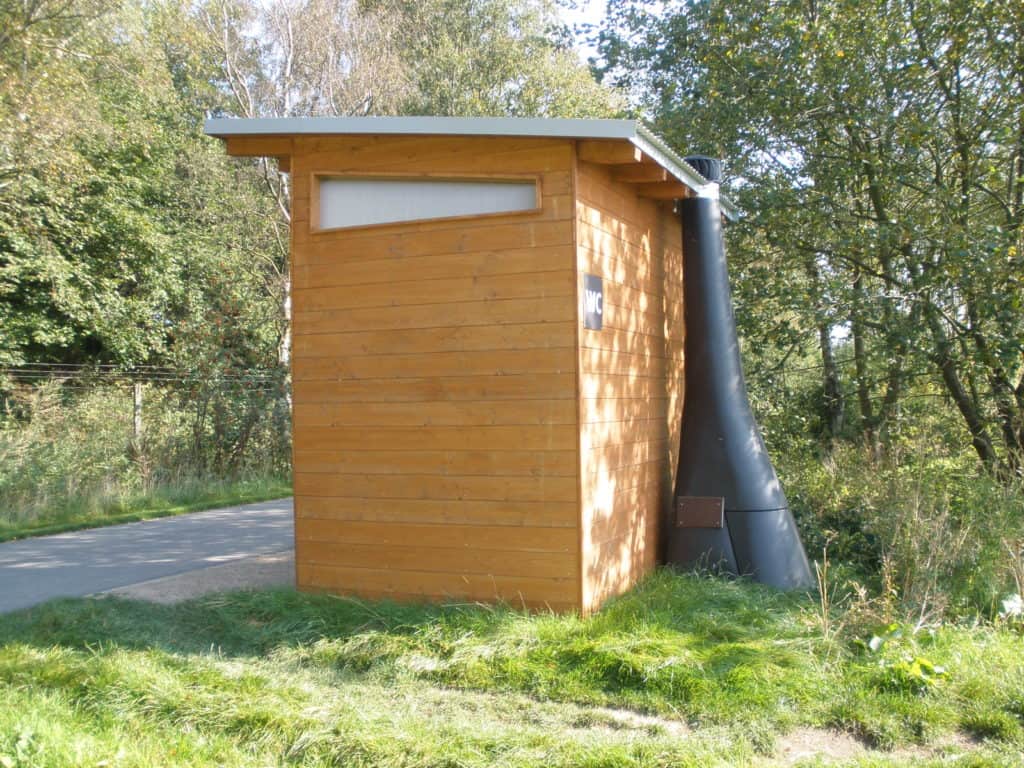
Why Should Individuals Use Waterless Composting Toilets in Their Homes?
There are many different types of composting toilets. A waterless toilet, often known as “dry sanitation” or “dry flush” systems, is toilets that do not utilize water to process or transport human waste.
Toilets that don’t flush with water have far less of an environmental footprint than water-efficient toilets and wastewater disposal systems!
If you care about the environment, a waterless toilet can help you conserve a vital resource in your house while also protecting the Planet from any more needless human-caused harm.
A dry flush toilet utilizes different technologies in waste disposal, some of these technologies include:
- Incineration– Waterless systems that are self-contained and do not require connection to a sewer system or an in-ground septic system. To incinerate human waste into sterile clean ash, they use electricity or natural or propane gas. An incinerating toilet system is simple to use, efficient, sanitary, and relatively straightforward to maintain when correctly installed.
- Poop vaporising- This technique works by vaporizing 75% of the overall water in human feces to create little dry turds that can be easily disposed of.
- Composting- This is the method of naturally breaking down human waste into compost that could be used to fertilize the soil. Before the bowl is emptied through a hygienic process, the toilets feature a composting chamber where the complete process is conducted.
- Nanotechnology– This waterless plumbing system is suited for off-grid situations since it works on batteries. It is also extremely beneficial to isolated homes since the waste products may be used to create electricity. When water is eliminated from feces, dry solids are left that are free of parasites and pathogens and may be used as fertilizer or fuel.
Bill and Melinda Gates were so impressed by this design when it caught their attention that they awarded a whopping $710,000 for its development.
The most common type of waterless toilet is composting toilet, however, there are many models to choose from.
Here are some examples of the best waterless toilet for your home:
Best overall: Nature’s Head Self Contained Composting Toilet
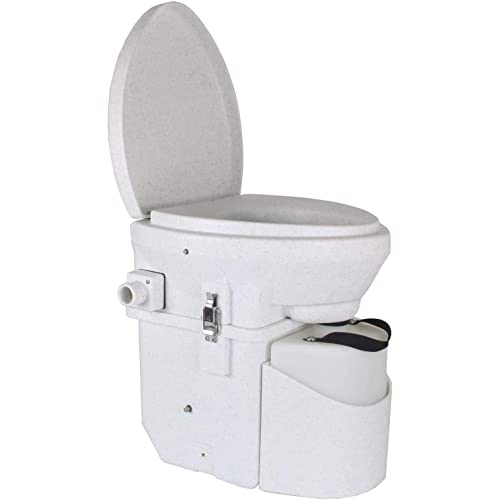
Because of its simplicity and compactness, this is a self-contained and portable type that uses a urine separating system, making it excellent for houses.
There are many features that make this the best overall waterless composting toilet-There is no holding tank, so the toilet is odor-free, and it has an integrated fan to improve air circulation for a fresher smelling environment.
Having no complex plumbing setup makes it easy to install, clean, and maintain.
Despite the many desirable features of this model, there are some drawbacks to consider. The toilet has a smaller urine container which tends to fill up faster than some other models, this means the bowl has to be cleaned out more frequently.
This also makes it more difficult to clean out solid waste. Finally, a deal-breaker for many, if the toilet malfunctions, there may be a slight odor.
Nature’s head dry composting toilet
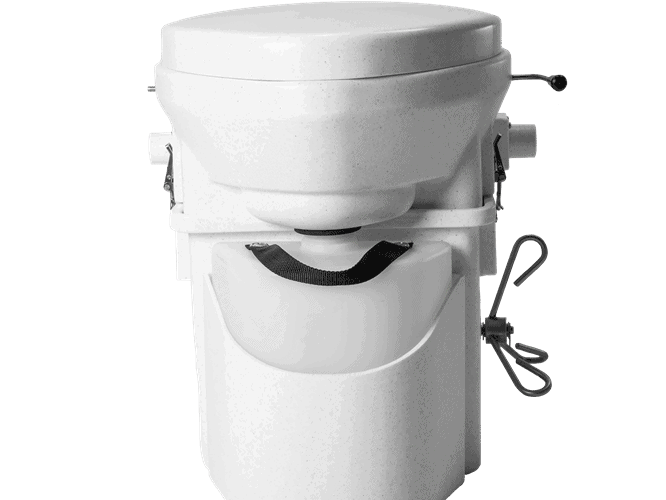
Due to its hand crank agitation in its core, Nature’s Head Dry Compost Toilet with Standard Crank Handle Design provides the users with a better and faster cleaning ability.
This waterless toilet functions on a urine-diverting mechanism and is self-contained. It is built-in with a 12v power plug and fan for low volume air circulation.
The maintenance for this toilet is fairly straightforward and easy to use, with a quick installation process.
It is free from bad smells and runs on a waterless operating system. However, the toilet requires the urine container to be emptied frequently.
Sun-Mar Excel Non-Electric Self-Contained Composting Toilet, Model Excel
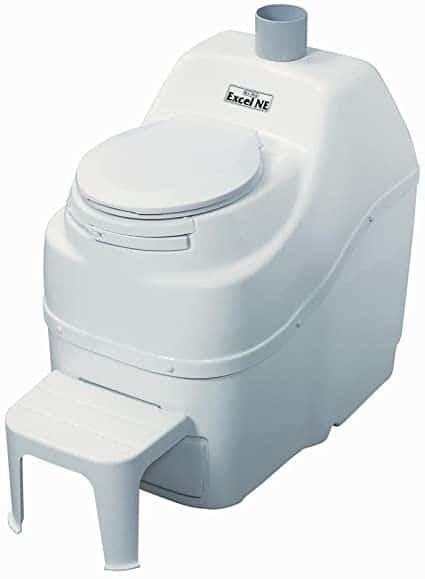
Despite being non-electric, the toilet is efficient in decomposition and disintegrates human waste without any smells from the process.
It is able to have up to 3 users in residential settings and up to 7 if installed in a cabin or used for weekend use. It has a waterless design and is not electric, whilst also being 100% non-polluting.
However, it is safe to say there are cheaper models in the market which can provide the same effect.
Laveo Chemical Free Odorless Portable Electric Waterless Toilet
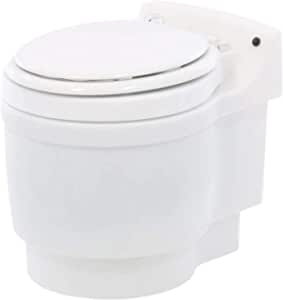
The DryFlush Laveo portable toilet is a light, waterless, odorless, and chemical-free commode that brings home comforts to even the most distant locations.
This device is portable and light. Its most notable feature is a ground-breaking waste-disposal technique.
Every time the toilet is flushed, a double-layered bagging mechanism goes to work, effectively categorising anything in the bowl by a twist-and-seal motion.
Refill cartridges store 15-17 flushes and are simple to change without exposing users to waste (and smell)—just remove the liner bag and empty it.
However, this may not be the cheapest or most effective option as it is not self-contained and is designed to be paired with the Sun-Mar centrex systems which need to be purchased separately.
This is why many people would consider an alternative, saving money.
Sun-Mar Centrex Nonelectric Waterless Ultra-Low flush central composting toilet system
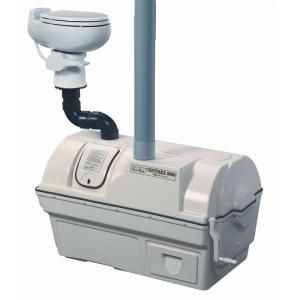
For mild to medium seasonal use, the Sun-Mar Centrex 1000-NE is recommended.
It was created with small places in mind, and is specifically designed for narrow spaces. It’s a non-electric unit for individuals who don’t have access to a constant 110-Volt power source.
An innovative Bio-drum is included in every Sun-Mar composting toilet, ensuring quick and odorless breakdown.
Thousands of gallons of water are being saved, and waste is recycled into the soil. This is an eco-friendly alternative and ideal for off-grid use.
However, some points to consider are that there is not much information on how it operates as well as its dimensions and size.
What are the main points you should consider before buying a waterless composting toilet for your home?
There are many things to consider before deciding on what waterless composting toilet to buy, some questions to ask yourself is:
- How much am I willing to spend?
- How will I dispose of solid waste and urine? – Human waste can pollute local water so ensuring you have sealed compost bins to dispose of it safely is important. you can drain urine into a rock pit.
- How will I vent it? – this can be done through the wall or roof but it is important to ensure what you need is supplied with the toilet.
- Is it legal? – It is legal in most places but to be sure, ask your local government office.
- How often am I able to empty the toilet? – Some require more frequent emptying, so be sure you find what’s the most time-efficient for you.
Conclusion
Many adults are looking into eco-friendly living to help the environment and live sustainably. And ditching your flush toilet for a composting toilet is a good place to start!
If this is a journey you wish to embark on, consider becoming an owner of an indoor waterless composting toilet for your bathroom at home.
With the wide variety of dry flush toilets for your bathroom (as well as boats, cabins, and even your trailer van or RV), you can easily find the best option for you.
And don’t forget, there are options to make your own DIY composting toilet if you are concerned about saving money or working on a lower budget.

